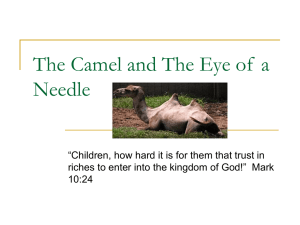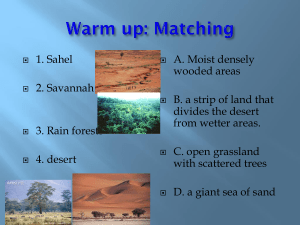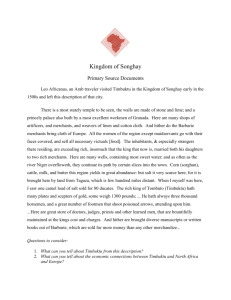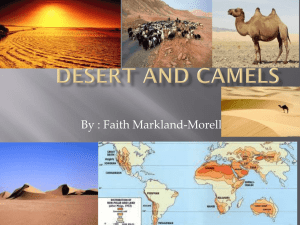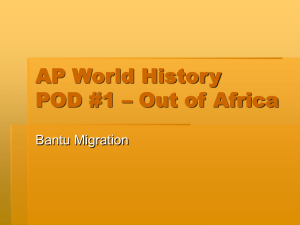Since the Middle Ages, camel caravans have navigated north from
advertisement
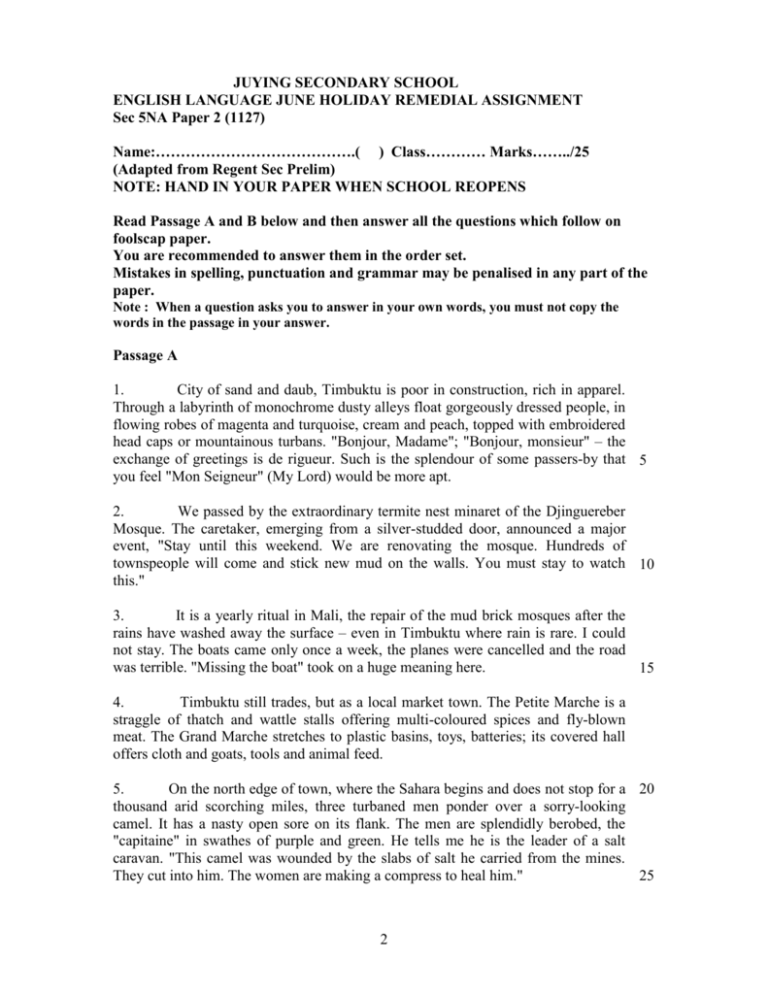
JUYING SECONDARY SCHOOL ENGLISH LANGUAGE JUNE HOLIDAY REMEDIAL ASSIGNMENT Sec 5NA Paper 2 (1127) Name:………………………………….( ) Class………… Marks……../25 (Adapted from Regent Sec Prelim) NOTE: HAND IN YOUR PAPER WHEN SCHOOL REOPENS Read Passage A and B below and then answer all the questions which follow on foolscap paper. You are recommended to answer them in the order set. Mistakes in spelling, punctuation and grammar may be penalised in any part of the paper. Note : When a question asks you to answer in your own words, you must not copy the words in the passage in your answer. Passage A 1. City of sand and daub, Timbuktu is poor in construction, rich in apparel. Through a labyrinth of monochrome dusty alleys float gorgeously dressed people, in flowing robes of magenta and turquoise, cream and peach, topped with embroidered head caps or mountainous turbans. "Bonjour, Madame"; "Bonjour, monsieur" – the exchange of greetings is de rigueur. Such is the splendour of some passers-by that 5 you feel "Mon Seigneur" (My Lord) would be more apt. 2. We passed by the extraordinary termite nest minaret of the Djinguereber Mosque. The caretaker, emerging from a silver-studded door, announced a major event, "Stay until this weekend. We are renovating the mosque. Hundreds of townspeople will come and stick new mud on the walls. You must stay to watch 10 this." 3. It is a yearly ritual in Mali, the repair of the mud brick mosques after the rains have washed away the surface – even in Timbuktu where rain is rare. I could not stay. The boats came only once a week, the planes were cancelled and the road was terrible. "Missing the boat" took on a huge meaning here. 15 4. Timbuktu still trades, but as a local market town. The Petite Marche is a straggle of thatch and wattle stalls offering multi-coloured spices and fly-blown meat. The Grand Marche stretches to plastic basins, toys, batteries; its covered hall offers cloth and goats, tools and animal feed. 5. On the north edge of town, where the Sahara begins and does not stop for a 20 thousand arid scorching miles, three turbaned men ponder over a sorry-looking camel. It has a nasty open sore on its flank. The men are splendidly berobed, the "capitaine" in swathes of purple and green. He tells me he is the leader of a salt caravan. "This camel was wounded by the slabs of salt he carried from the mines. They cut into him. The women are making a compress to heal him." 25 2 6. It is here, at the quarter called Abaradiou, that the caravans have always arrived, and still do with the last commodity now traded, rock salt. "I spend four or five months at Taoudenni each year," the captain says. "I take workers there and oversee them. It takes 15 days to get there." 7. This is the last echo of an age old commerce, for in the Middle Ages, salt 30 was so valuable that it was traded weight for weight with gold. The black people of tropical Africa were willing to equate the gold of their rainforest mines with the salt of the desert mines. 8. Taudenni is some 800 kilometres north in the fierce heart of the Sahara. There, in the fearful void, in the dried-up bed of an ancient lake, the miners toil in 35 appalling conditions, living in rock salt caves, tantamount to slaves, another "commodity" that once made Timbuktu rich. Some things do not change. Adapted from “Timbuktu” by Keith Mundy Passage B 1. Since the Middle Ages, camel caravans have navigated north from the fabled city of Timbuktu, in present-day Mali, West Africa, in search of the gold of the Sahara desert—salt. Travelling across the windswept sand dunes, caravans, often numbering more than hundred, have journeyed to the salt mines of Taudenni, 800 kilometres north of Timbuktu. A human necessity and source of commerce, salt has 5 been in high demand in West Africa since the 12th century when it was first found in the sand dunes of the desert. 2. Its discovery gave rise to a robust commodity trade that quickly paved a nearmythical trail connecting Timbuktu with Europe, southern Africa, and Persia. With the trade of Taudenni's prized salt, came the ability to move people, information, and 10 ideas across the Sahara desert. During the 12th and 13th centuries, Timbuktu became not only a centre of great wealth but of Islamic study. Scholars from across the Islamic world, some from as far away as Persia, journeyed for months across the sands of the Sahara in order to teach and study in the mysterious oasis of Timbuktu. 3. Today, the great camel caravans of Timbuktu still journey for 14 days and 15 some 800 kilometres to the salt mines of Taudenni. At the salt mines, a working mine could be distinguished from out of the sandy haze of the desert, a mythical scene from an ancient painting. The mine has been cut out of a primal sea-bed, an empty sandy region that stretches in every direction. Several hundred men work at the mines as indentured slaves, chipping away at the ground beneath the Earth in 20 musty, salt-choked caves. 4. Once the salt has been cut from the mine, slabs are loaded onto camel caravans. The caravans head south towards Timbuktu, traveling nearly two weeks through featureless sand dunes that warp the mind's depth perceptions. What appears to be close is in fact on the horizon. What appears to be miles away, becomes a 25 small rock that one discovers yards from where you stood. The Sahara desert 3 surrenders very few realities, only illusions. 5. Local Tamashek and Berbers who lead the camel caravans know the power of the emptiness of the Sahara. "To go into the desert is to go into the realm of the 30 spirit," said retired University of Timbuktu Professor Salem Uld Elhagg. "Because a young camel leader must journey into the desert, and into its isolation, he will suffer. It is through that fear that he will have a spiritual awakening. The desert will lead a man to Allah, to God." 6. The camel caravans are led by one person, a tracker across the emptiness of 35 the desert. The workers, sometimes young boys on their first journey into the desert, put their trust in the guides who are chosen to lead the caravans across the emptiness of the sand. Guides are chosen because of their special ability to read the desert and determine exactly where they are. To be in error by even a few miles can bring certain death in a place where water is measured in drops, and nothing grows for 40 thousands of miles. The guide must also have a good knowledge of the desert’s wind conditions. His responsibility is to lead camels and men to the salt mine to the north and then return to Timbuktu to the south. 7. Tamashek guides lead caravans of trucks, armed only with the knowledge of the prevailing wind patterns across the sand, the stars etched across the night sky, 45 the changing colour of the sand, and vintage WWII compasses, often hopelessly cracked across the glass, but still somewhat reliable. To mark each day, the guides predict exactly when the troupe would arrive at the next water hole. The natural springs and wells are the lifeline of every man that passes through desert. 8. For centuries, camel caravans and the trackers have traversed the Sahara 50 desert in search of the salt of Taudenni. The journey for salt for most who have braved the magnitude of Sahara's isolation represents far more than a quest for economic gain. It becomes a journey into the soul, a journey of renewal for a follower of Islam, a chance to step closer to his God. 9. In recent years, the camel caravan salt trade has been threatened by the 55 arrival of 4x4 trucks that make the arduous journey in a matter of days. With the introduction of this new technology, the price of salt has dropped, threatening the livelihood of those who lead the camel caravans. Adapted from National Geographic News: In Sahara, Salt-hauling camel trains struggle on by Chris Rainier 4 FROM PASSAGE A From Paragraph 1 1) The city of Timbuktu is “poor in construction, rich in apparel” (line 1). Explain in your own words what the author means by this. [2] From Paragraph 2 2) What evidence is there in this paragraph to indicate that the people of Timbuktu have a strong sense of community spirit? [1] From Paragraph 3 3) The author mentions at line 14 that the “planes were cancelled”. Suggest a reason for the cancellation. [1] From Paragraph 4 4) What do the “The Petite Marche” (line 16) and the “Grand Marche” (line 18) refer to? [1] From Paragraph 5 5) Explain what is meant by a “compress” mentioned at line 25 ? [1] From Paragraph 8 6) The desert is looked upon by the locals as a “fearful void” (line 35). Explain the phrase in your own words. [1] 7) “Some things do not change.” (line 37) What is the author referring to here and what does he mean? [2] FROM PASSAGE B From Paragraph 1 8) Explain in your own words why salt is referred to as the “gold of the Sahara desert” (line 2). [1] From Paragraph 2 9) Which word in this paragraph suggests that the salt trade was rather brisk? [1] 5 From Paragraph 3 10) The author describes one of the present day mines as a scene from “an ancient painting” (line 18). What could have led him to have this impression? [1] 11) The miners are like “indentured slaves, chipping away at the ground beneath the Earth in musty salt-choked caves.” (line 20) State in your own words what this tells you about the life the miners lead. [2] From Paragraph 4 12) The surrounding regions often appear distorted. Write down the phrase that tells you this. [1] From Paragraph 5 13) Explain fully why a journey into the desert is associated with spiritual awakening to a young Muslim. [2] From Paragraph 6 14) How would the knowledge of prevailing wind conditions be helpful to a guide leading camels and men? [1] From Paragraph 9 15) Explain fully why the introduction of 4x4 trucks threatens the livelihood of those who lead the camel caravans. [2] From Passages A and B 16) For each of the following words or phrases, give one word or short phrase (of not more than seven words) which has the same meaning that the word or phrase has in the passage. [5] From Passage A: From Passage B: a) labyrinth (line 2) b) apt (line 6) c) appalling (line 36) d) traversed (line 49) e) arduous (line 55) ~End of Paper~ 6

